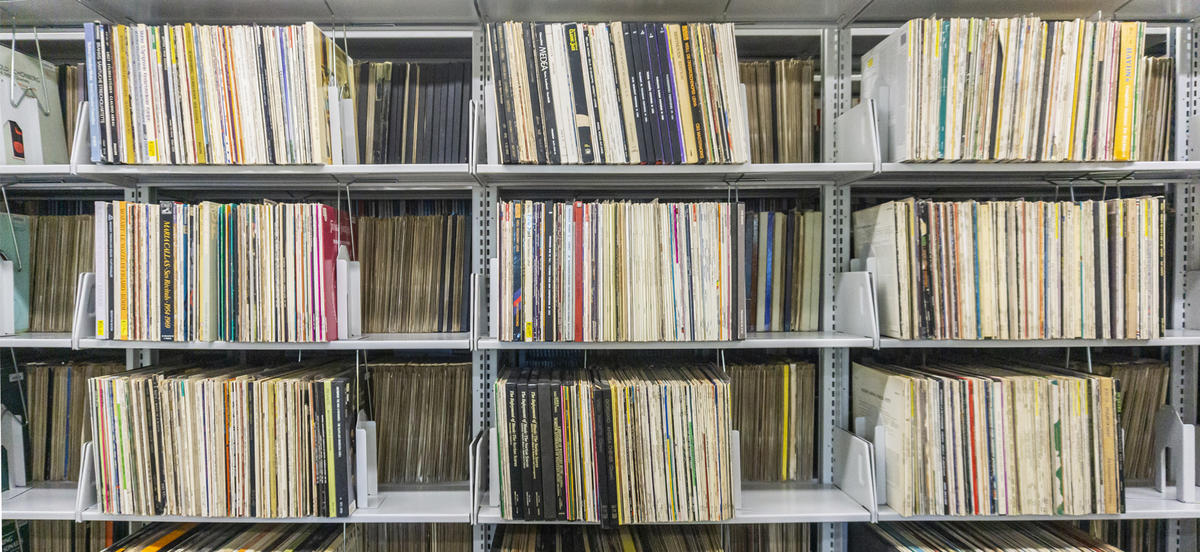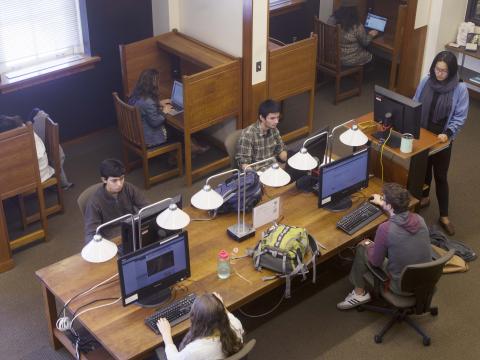Staff Spotlight: Guillermo Gómez

Vinyl in the stacks of the Nan and Bill Harris Music Library.
Details
In this edition of the Staff Spotlight the Music Librarian and Coordinator of User Experience, Guillermo Gómez, answers questions about his work at Haverford's Libraries. He discusses resources at the Nan and Bill Harris Music Library, collection development, and the user's experience.
- What do you want the Haverford community to know about the music library?
“I want the community to know that it’s a very robust collection…unique” Guillermo stated. The collection contains physical and digital music scores, streaming media for both listening and viewing, journals, books, and equipment that can be borrowed for recording projects. Whether you are a music student looking for research materials to support coursework or looking to explore an interest in music, the Music Library welcomes you to take advantage of the plethora of resources offered. “We are here to serve everybody,” Guillermo said. “I love requests from students. I try to welcome any suggestions, and as long as they serve educational purposes, I will try to add them to the collection.”
To learn more about collection offerings, please visit the Music LibGuide at https://guides.tricolib.brynmawr.edu/music.
- How do you choose materials for the music collection?
Guillermo emphasized the importance of working closely with faculty to support the curriculum, and scholarship through collection development. “My first priority is consulting with faculty in the music department to see what they need for courses.” He views this close relationship as “a guiding principle, fostering an academically rigorous and culturally aligned collection.” He adds, “I also see the larger picture.” He sees the collection in a broad context, tracing the continuum of musical inspiration from classical pieces to contemporary works, and regards collection development as an “inclusive decision-making process.” Collaboration in collection development extends past the Haverford community, and Guillermo works with Donna Fournier, Swarthmore College’s Performing Arts Librarian, “ensuring a comprehensive and inclusive music collection catering to diverse interests and academic pursuits.”
- Why does the user’s experience matter to the libraries?
User Experience (UX) is at the core of the Libraries’ mission; library staff “recognize and prioritize the user experience for several reasons.” Haverford’s Libraries aim to provide the best access to patrons, and this means taking into account accessibility and inclusivity. “The Libraries aim to be welcoming spaces for a diverse community of users with varying needs and preferences,” looking to foster engagement with patrons, taking advantage of the resources available. Guillermo explains that “this engagement contributes to a vibrant and dynamic library experience…and ultimately supports patron’s academic and intellectual goals.” This effort includes designing spaces and choosing technology that make it easier for patrons to locate and utilize materials, thereby enhancing the overall value of the library's offerings. Through the prioritization of UX, the Libraries demonstrate a commitment to meeting the evolving needs of their patrons.
- How does equity factor into collection development in the music library?
“The goal of an equitable approach is to create an inclusive, representational collection that aligns with broader objectives of social justice, belonging, and equitable access to knowledge and cultural heritage through music,” says Guillermo. He considers “a diverse range of perspectives while developing the collection and actively works to identify gaps that may exist, believing that “breadth enriches the academic experience, fostering an inclusive environment for exploring diverse musical expressions.” Additionally, accessibility of resources leads Guillermo to consider material formats, digital access, and affordability.
- What is the most interesting resource you have encountered in the music library?
“There are many!” Guillermo enjoys the facsimile editions of musical works, whereby the viewer can see a photographic representation of the composer's manuscript, an early copy of the work, or a first edition of the work in their own handwriting. For example, the facsimile of Beethoven’s Symphony No. 9 in D minor, Op. 125. Viewing this piece's original, handwritten copy provides an intimate, personal view of the work. The facsimile contains drafts and corrections, showing Beethoven’s meticulousness. Handel’s facsimile of Messiah (HWV 56) contains ink smears, stains, and drips, showing the urgency of Handel’s writing. Handwritten musical notes that are challenging to decipher further demonstrate the importance of music editors and Urtext editions of musical published works. Guillermo also enjoys the “Monuments” (also known as ‘Denkmäler’) – multi-volume series in which the majority of individual volumes present a unified musical repertory derived from the same or closely related original sources.
Interesting resources available to patrons at the Harris Music Library:
Raga Mala – The Autobiography of Ravi Shankar
- What are you (writing)/learning about?
Guillermo is taking courses in music mixing, editing, and production. He is also learning about Python programming. To learn more about music production and Python along with Guillermo, check out these links in Tripod:
Python By Example: LearnStorying to Program in 150 Challenges
Learn Python Programming with Games
Music Production: Learn How to Record, Mix and Master Music
Innovation in Music: Performance, Production, Technology, and Business
Guillermo is also re-visiting some of his past compositions, mainly “Life’s Journey,” for String Quintet and Piano and “Return To Symplicity” for Percussion, as well as expanding his music software and hardware collection in preparation for future projects.
- What are you reading?
Guillermo is reading three different books, all about the evolution of music and artists.
Brothers and Sisters: The Allman Brothers Band
- What music are you listening to?
Guillermo is currently listening to a broad range of music that inspires him as both a musician and as a librarian.
Adagio for Strings by Samuel Barber
Synchronicity by The Police
Nevermind and In Utero by Nirvana
“Tonight, Tonight” by The Smashing Pumpkins
“Enjoy the Silence” by Depeche Mode
“Human” by The Human League
“Once in a Lifetime” by The Talking Heads
Don’t Dream It’s Over by Crowded House
LA Woman by The Doors

